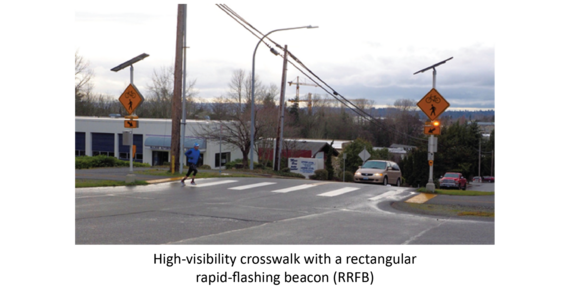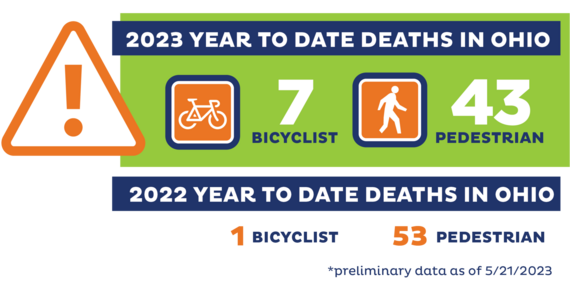Designing Appropriate Crossings at Uncontrolled Locations
An uncontrolled crossing is a crosswalk where there are no traffic control devices (such as stop signs or traffic signals). Uncontrolled crosswalks are very common, and they may exist at intersections or at midblock locations. Pedestrians have the right of way at uncontrolled crossings. By layering countermeasures to design appropriate uncontrolled crossings, we can address the significant national safety problem of pedestrian injuries and fatalities, and we can improve conditions for those walking in our communities.
What are the challenges at uncontrolled crossing locations?
Most challenges at uncontrolled crossings can be broken down into two main categories: challenges with visibility and challenges with yielding. The first challenge (visibility) is making sure that people driving can see the crosswalk and recognize that they should expect pedestrians to cross there. The second challenge (yielding) is making sure that people driving slow down and yield to pedestrians once they have seen them.
How do we increase visibility at uncontrolled crossings?
The FHWA Guide for Improving Pedestrian Safety at Uncontrolled Crossing Locations recommends that the following countermeasures for improving visibility be considered at every marked uncontrolled crossing:
-
High-visibility crosswalk markings: High visibility crosswalk markings (see right image below) are more visible than transverse crosswalk markings (see left image below). Research shows that high visibility crosswalk markings can be seen from twice as far away as transverse crosswalk markings, giving drivers more time to react appropriately. Some communities may worry that using too many high-visibility crosswalks will reduce their effectiveness, but there’s no research to back this up. Upcoming guidance from the FHWA Crosswalk Marking Selection Guide (not yet published) is expected to state that any crosswalk worth marking is worth marking as a high-visibility crosswalk.

-
Crossing warning signs: In addition to high-visibility markings, pedestrian warning signs (W11-2) and school crossing signs (S1-1) can enhance the visibility of a crosswalk and make drivers aware of the possible presence of pedestrians.
-
Parking restrictions: Parked cars right next to a crosswalk make it harder for drivers to see pedestrians starting to cross. Restricting parking for 20 feet on the approach to a crosswalk (using pavement markings, signage, or curb extensions) can give drivers and pedestrians a clear line of sight to see each other.
-
Lighting: Adequate lighting at an uncontrolled crossing makes it easier for drivers to see pedestrians at night, which is when 75% of pedestrian fatalities occur. Lighting should illuminate the person crossing from the front; avoid a pedestrian being back lit from the perspective of a driver.
How do we encourage drivers to yield to pedestrians in crosswalks?
The likelihood of a driver yielding to a pedestrian crossing is directly related to the speed of the driver; as speed increases, yielding decreases. Research shows that high-visibility markings increase the chance that a driver will yield to pedestrians (as opposed to transverse crosswalk markings), but this is not the case as speeds exceed 30 mph. There are many strategies that can be used to calm traffic at crosswalks and increase the likelihood of a driver yielding to pedestrians.
-
Horizontal deflection: Horizontal deflection measures, such as curb extensions or a pedestrian refuge island, narrow the roadway at the uncontrolled crossing location, encouraging drivers to slow down. In general, the slower a driver is traveling, the more likely they are to yield to a pedestrian in a crosswalk, as the law requires.
-
Vertical deflection: Raised crosswalks (which function similarly to speed tables or speed humps) are a design treatment that uses vertical deflection to encourage drivers to slow down.
-
Pavement markings: Many uncontrolled crossings use advance yield markings to show drivers where they should slow down to yield to pedestrians. In addition to encouraging yielding, these markings can help reduce the risk of a multiple-threat crash. A multiple-threat crash happens at multi-lane crossings, where a driver stopping close to the crosswalk to allow a pedestrian to walk may block the pedestrian from the view of a motorist in the adjacent lane.
 Layering Countermeasures
The FHWA recommends that visibility enhancements be considered at all crosswalks, but in most cases, visibility enhancements should occur in conjunction with other identified countermeasures. This is especially true on roadways with more than one lane in each direction, with volumes over 9,000 AADT, or with speeds over 40 mph. High speeds make it less likely that people driving will yield to pedestrians, and high volumes make it more difficult for pedestrians to find gaps in traffic where they can cross. Use Table 4-6 from ODOT’s Multimodal Design Guide to determine what countermeasures should be considered for different roadways to create frequent and safe crossing opportunities.
Additional countermeasures to consider in conjunction with visibility enhancements and horizontal/vertical deflection may include:
 Additional Resources
To learn more about designing appropriate crossings at uncontrolled locations, see the resources below:
 Announcements
- ODOT is seeking input from local governments about pedestrian and bicycle safety via a survey! Please take 10 minutes to participate and share your perceptions and concerns regarding ped/bike safety in your community. Responses are due by June 7. Please share with local government staff in your network (local planner/engineer, administration, law enforcement, council, etc.).
- May is Bike Month – an opportunity to showcase the many benefits of bicycling! Free materials are available at Bikeleague.org.
- Check out ODOT’s updated Safe Routes to School Infrastructure and Non-Infrastructure Toolkits for ideas to support kids walking or biking to school safely.
- ODOT is pleased to offer the opportunity for local communities to host a Professional Development Ride. During a three-hour ride, a small group of decision makers ride bikes along a customized route in their community. Interested? Apply through the Active Transportation Academy – spaces are limited.
- LTAP is offering two sessions of the half-day Inspecting Curb Ramps course at Central Office in Columbus. Registration is required: May 30– 8:30am to 11:45am, or May 30, 1:00pm to 4:15pm
- Safe Streets and Roads for All (SS4A) funding applications are open through July 10. View the Notice of Funding Opportunity or visit the SS4A website.
- ODOT and MVRPC are hosting a Multimodal Design Guide training taking place Thursday June 29th in Dayton, Ohio. Space is limited, register today!
- LTAP is offering a Road Safety Audit Course August 2-3 at Central office. Registration is required.

|